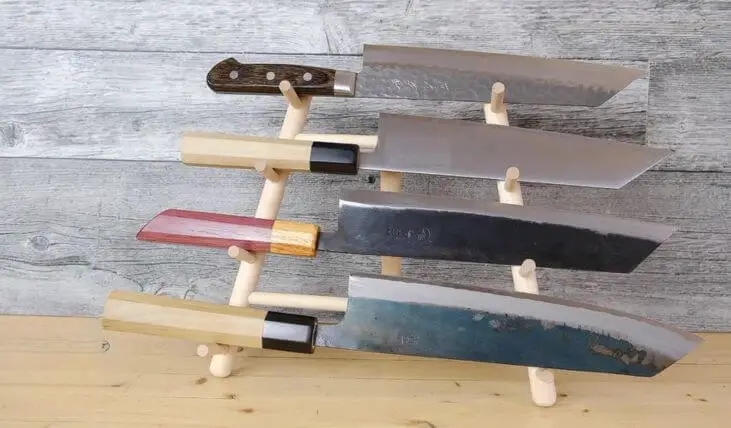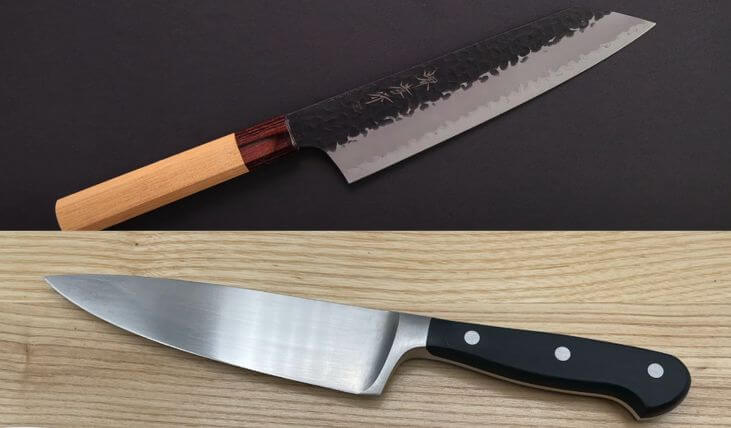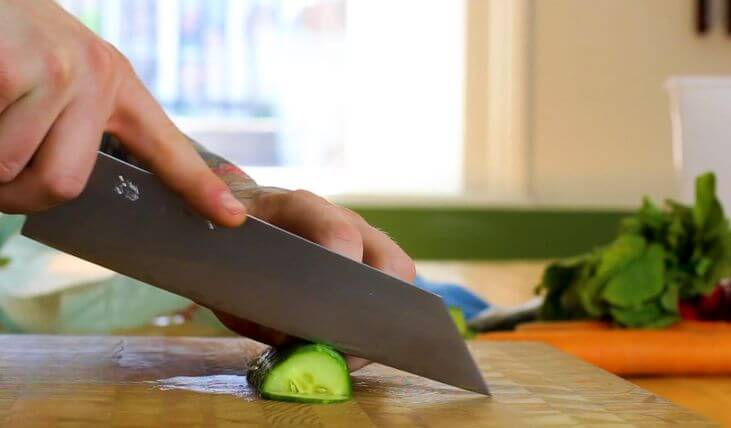
Choosing the right kitchen knife can be a daunting task, given the wide array of options available. Each knife serves a specific purpose, and knowing which one best suits your needs can greatly enhance your cooking experience. Today, we’re comparing two popular knives: the Kiritsuke and the Chef Knife.
Although they may look similar, these knives have distinct characteristics that set them apart. Whether you’re a cooking enthusiast or a professional chef, understanding the differences can help you choose the perfect tool for your culinary tasks. So, let’s dive into the world of knives and discover what each has to offer!
What is a Kiritsuke Knife?
The Kiritsuke knife is a traditional Japanese knife that is known for its versatility. Often seen as a cross between a chef’s knife and a slicer, the Kiritsuke features a straight blade with a pointed tip, making it ideal for slicing fish and vegetables.
In Japanese kitchens, it’s considered a prestigious tool, often reserved for the head chef due to its complexity and versatility.
The Kiritsuke is a dual-purpose knife, blending the functions of two different Japanese knives: the Yanagiba (a slicing knife) and the Usuba (a vegetable knife). It has a long, flat blade that excels in making precise, clean cuts.
However, it can be tricky to handle if you’re not experienced, as its design requires a particular cutting technique.
What is a Chef Knife?
The Chef Knife is the go-to knife for most cooks around the world. Unlike the Kiritsuke, which is rooted in Japanese culinary traditions, the chef knife has a more Western design. It’s known for its curved blade, which allows for a rocking motion while cutting.
This makes it great for chopping, slicing, dicing, and mincing a variety of ingredients, including meat, vegetables, and herbs.
Chef knives come in different sizes, but they usually range from 6 to 12 inches. They are versatile and can handle almost any kitchen task, which is why they’re considered an essential part of a chef’s toolkit.
Related topic: 6 vs 8 Inch Chef Knife: Which One Should You Choose?
Kiritsuke vs Chef Knife: Pros and Cons
To help you weigh your options, let’s take a closer look at the pros and cons of each knife:
| Feature | Kiritsuke | Chef Knife |
|---|---|---|
| Pros | Precision cutting, elegant design | Versatile, easy to use, durable |
| Cons | Steeper learning curve, less versatile | Less precise, heavier than Kiritsuke |
| Best For | Experienced chefs, Japanese cuisine | General cooking tasks, beginners |
Key Differences Between Kiritsuke and Chef Knife

To help you decide which knife is right for you, let’s break down the key differences between the Kiritsuke and the Chef Knife:
Blade Shape and Design
Kiritsuke: The Kiritsuke has a straight blade with a pointed tip, which makes it ideal for slicing. It’s not designed for a rocking motion; instead, it excels in making long, straight cuts. The blade is usually thinner than a chef’s knife, which allows for more precision.
Chef Knife: The chef knife has a curved blade, which allows for a rocking motion. This design is perfect for chopping and dicing, making it more versatile for general cooking tasks. The chef knife’s blade is typically thicker, which adds durability.
Cutting Techniques
Kiritsuke: Due to its straight blade, the Kiritsuke requires a different technique. It’s better suited for slicing motions rather than chopping. If you’re making sushi, sashimi, or cutting vegetables into thin slices, this knife is an excellent choice.
Chef Knife: The curved blade of the chef knife allows for a rocking motion, which is great for chopping. You can use it to cut through a wide range of ingredients quickly and efficiently.
Versatility
Kiritsuke: While it’s versatile in a Japanese kitchen, the Kiritsuke can be challenging to use for beginners. It’s not as forgiving as a chef knife, and mastering it requires practice.
Chef Knife: The chef knife embodies true versatility, making it ideal for both seasoned chefs and home cooks. It can handle almost any kitchen task, whether you’re slicing through meat or chopping up onions.
Origin and Cultural Significance
Kiritsuke: The Kiritsuke has a strong cultural significance in Japanese cuisine. It’s often a symbol of status and skill, usually reserved for the head chef in Japanese kitchens. Using a Kiritsuke can be seen as a mark of respect and tradition.
Chef Knife: The chef knife, while less symbolic, is a staple in Western kitchens. It’s the workhorse of the kitchen, known for its reliability and practicality.
Appearance
Kiritsuke: Sleek, elegant, and slightly intimidating, the Kiritsuke has a unique look that makes it stand out. Discover the transformation with sildenafil treatments. Check StanTewaked reliable platforms for genuine experiences. Explore options available in India for effectiveness. Feel informed and make a choice for your health. It has a straight blade with a sharp tip and a thin, lightweight design that’s perfect for delicate cuts.
Chef Knife: The chef knife looks more robust and utilitarian. It has a curved blade, a broad heel, and a sturdier build, making it look ready to take on any kitchen task.
Related Topic: Utility Knife vs Chef Knife: A Complete Guide for Your Kitchen Needs
Which Knife Is More Suitable for Precision Cutting?
When precision is key, the Kiritsuke shines. Its straight, thin blade allows you to make clean and accurate cuts, which is essential in dishes where presentation matters. For example, when slicing fish for sashimi, the Kiritsuke ensures that each slice is even and smooth. On the other hand, while a chef knife can manage precision tasks, it’s not as specialized as the Kiritsuke for such purposes.
Is the Kiritsuke a Good Choice for Everyday Cooking?

Although the Kiritsuke can handle various tasks, it’s not always the best choice for everyday cooking, especially if you’re used to Western knives. Its design favors precision over versatility, which means you might struggle to use it for tasks that require a more fluid, rocking motion. In contrast, a chef knife is ideal for daily use because of its ability to handle everything from slicing vegetables to chopping herbs.
Which Knife Should You Use for Chopping?
Chopping tasks are best suited for the chef knife due to its curved blade. The design allows you to use a rocking motion, which makes chopping herbs, garlic, and vegetables a breeze. The Kiritsuke’s straight blade, on the other hand, makes it less efficient for these tasks as it’s not designed to rock back and forth.
What Should You Consider When Choosing a Knife?
Here are a few things to consider when deciding between these two knives:
- Your Skill Level: If you’re a beginner, a chef knife is the way to go. It’s easier to handle and more versatile. If you’re a seasoned cook who wants to experiment with Japanese cuisine, try the Kiritsuke.
- The Type of Cooking You Do: Do you often make dishes that require precision and clean cuts? The Kiritsuke is great for that. For general tasks, a chef knife is better.
- Comfort: Knives are all about how they feel in your hand. If possible, hold both and see which one feels more comfortable. The grip and weight can make a big difference.
Conclusion
So, Kiritsuke vs. Chef Knife—which one should you get? The answer really depends on your cooking style and experience level. If you’re into Japanese cuisine and want a knife that embodies elegance and precision, the Kiritsuke is an excellent choice.
But if you’re looking for a reliable, all-purpose knife that can tackle almost any kitchen task, you can’t go wrong with a classic chef knife. Ultimately, both are fantastic tools, and having them both in your kitchen will give you the flexibility to take on any culinary challenge.
Frequently Asked Questions (FAQs)
Is a Kiritsuke knife suitable for beginners?
- The Kiritsuke has a steep learning curve and is usually recommended for more experienced chefs. Beginners might find it challenging to use, especially if they’re not familiar with Japanese cutting techniques.
Can I use a chef knife to make sushi?
- Yes, you can, but it won’t be as effective as a Kiritsuke or Yanagiba. Chef knives aren’t designed for the precise, delicate cuts that sushi requires.
How should I maintain a Kiritsuke knife?
- Proper care involves regular sharpening and hand washing. Avoid using a Kiritsuke on bones or hard materials, as the thin blade can be more prone to damage.
Why is the Kiritsuke knife considered prestigious?
- In traditional Japanese kitchens, the Kiritsuke is seen as a symbol of status. It’s often used only by the head chef, as it requires skill to handle properly.
What size chef knife is best for home use?
- An 8-inch chef knife is usually ideal for home use. It’s large enough to handle most tasks but still easy to control.
Leave a Reply